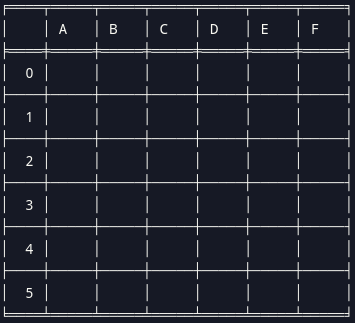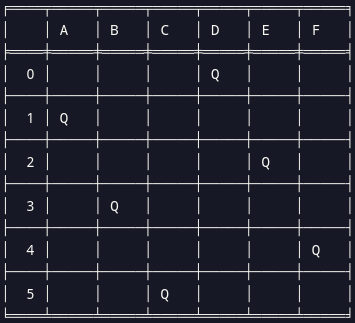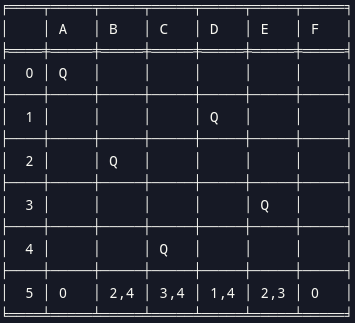We are going to cover the concept of Backjumping which is an improvement to the Backtracking Algorithm. We will solve the N-Queens Problem by making use of the Backjumping Algorithm. The Time and Space Complexity will be discussed at the end of the article.
Table of contents:
- Introduction
- Backjumping
- Time and Space Complexity
- Conclusion
Introduction
The goal of the “N-Queens Problem” is to arrange N queens on a N × N chessboard so that none of them can attack one another by being in the same row, column, or diagonal. The problem has a simple solution when N = 1 and there is none when N = 2 and N = 3. The answer to the N-Queens problem, when N (board size) = 6, is as follows.
| N-Queens Problem | Solution |
|---|---|
 |
 |
The Gaschnig’s Backjumping algorithm will be used to solve the “N-Queens Problem”. It attempts to minimize the number of nodes visited within the search tree and consequently reduce the number of consistency checks performed by the search process.
Backjumping
Gaschnig’s Backjumping algorithm only backjumps in leaf dead ends. In other words, when one reach a dead end in the search tree, it do not go back to the parent node all the time (Backtracking method), but rather to an earlier ancestor node in the search tree. It performs only safe and maximal jumps, jumping back as much as possible without precluding solution (i.e miss out on any possible solutions.)
Steps
- We begin solving from the leftmost column of the board.
- A valid solution is obtained if all the queens are placed.
- Place the queens one after the other in columns.
- We check for all rows in the current column for constraints before placing.
- If no other Queens are in the same row or diagonal and thus satisfy the constraints, we will place that Queen at that location and record the row and column as part of the solution matrix.
- If such a column does not exist, the algorithm will return false and performs a backjump.
Let’s take a closer look at the algorithm.
Pseudocode
backjump_solver(starting_row)
if(a queen in placed in every columns)
return true
for(all rows in the current column)
if (safe_to_place(column, row) is true)
return true
backjump max(conflict_set)
Implementation

To illustrate the conflict set concept, the Queen at row 5 is in conflict with Queen at (row 0), (rows 2 and 4), (rows 3 and 4), (rows 1 and 4), (rows 2 and 3) and (row 0).
In this instance, a dead end is reached in the search tree. To perform a safe and maximal jump, only the earliest row that is in conflict will be selected. The resulting conflict set will be rows(0, 2, 3, 1, 2, 0). To determine the maximal jump, we will select the latest row that is in conflict. The Backjumping algorithm will jump to the Queen at row 3.
Implementation of the above backtracking algorithm :
The numpy, string and tabulate libraries are imported to enable us to “pretty print” our results in a table format. The use of dictionary comprehension below is to construct the conflict_set variable which tracks the “row in conflict” during the placing of the Queens across the columns.
import numpy as np
import string
from tabulate import tabulate
class NQueenSolver:
def __init__(self, size_of_board):
self.size = size_of_board
self.columns = []
self.num_of_places = 0
self.num_of_backjumps = 0
self.conflict_set = {new_list: [] for new_list in range(self.size)}
The place_queen function take in a variable starting_row and we will set the initial value as 0. If the length of the variable columns is equal to the variable size, this means that every column has a queen and we have found a solution. Our program will proceed to print out the solution.
def place_queen(self, starting_row=0):
if len(self.columns) == self.size:
print(f"Board size: {self.size} x {self.size}")
print(f"{self.num_of_places} attempts were made to place the Queens which include {self.num_of_backjumps} backjumps.")
return self.columns
If no solution is found yet, we will proceed to search for a safe location to place the Queen. A for loop is used to check each row in the current column for a safe location to place the Queen. Details of the is_safe function will be explained later in this article. If a safe location is found, the row location will be recorded in the columns variable and the place_queen function will be called to proceed to work on the next column.
else:
for row in range(starting_row, self.size):
if self.is_safe(len(self.columns), row) is True:
self.columns.insert(len(self.columns),row)
self.num_of_places += 1
return self.place_queen()
If we are unable to find any safe location for the current column, we will retrieve the conflict_set for the particular column. The greatest value of the conflict_set will be the maximal column to backjump to. The column that we backjumped to and the subsequent columns will be emptied by setting their value to []. The place_queen function will be called to proceed to work on the backjumped column.
max_jump = self.conflict_set[len(self.columns)]
max_jump = set(max_jump)
last_row = max(max_jump)
self.num_of_backjumps += 1
for i in range(last_row+1, self.size):
self.conflict_set[i] = []
previous_variable = self.columns[last_row]
self.columns = self.columns[:last_row]
return self.place_queen(starting_row = previous_variable+1)
The is_safe function determine whether a position to place the Queen is safe. The first portion if row == conflict_row check for horizontal conflicts. The second portion elif abs(conflict_row - row) == abs(conflict_col - col): check for diagonal conflicts (they are on the same diagonal if their delta are the same).
In both conflict check, the column that is in conflict will be recorded in the conflict_set variable.
def is_safe(self, col, row):
for conflict_col, conflict_row in enumerate(self.columns):
if row == conflict_row:
self.conflict_set[col].append(conflict_col)
return False
elif abs(conflict_row - row) == abs(conflict_col - col):
self.conflict_set[col].append(conflict_col)
return False
return True
The below codes will attempt to run our N-Queen solver program.
size = input("Enter the size of the board:")
n = int(size)
queens = NQueenSolver(n)
queens.place_queen(0)
We convert the result to a numpy array for “pretty printing”. We used string.ascii_uppercase to create our header row labels and tabulate function display the numpy array in a grid format.
board = np.full((n, n), " ")
for col_queen, row_queen in enumerate(queens.columns):
board[row_queen][col_queen] = 'Q'
headers = list(string.ascii_uppercase)
headers = headers[:n]
table = tabulate(board, headers, showindex=range(0,n), tablefmt="fancy_grid")
print(table)
Once we run the code, we should see the following output.
Board size: 6 x 6
31 attempts were made to place the Queens which include 20 backjumps.
╒════╤═════╤═════╤═════╤═════╤═════╤═════╕
│ │ A │ B │ C │ D │ E │ F │
╞════╪═════╪═════╪═════╪═════╪═════╪═════╡
│ 0 │ │ │ │ Q │ │ │
├────┼─────┼─────┼─────┼─────┼─────┼─────┤
│ 1 │ Q │ │ │ │ │ │
├────┼─────┼─────┼─────┼─────┼─────┼─────┤
│ 2 │ │ │ │ │ Q │ │
├────┼─────┼─────┼─────┼─────┼─────┼─────┤
│ 3 │ │ Q │ │ │ │ │
├────┼─────┼─────┼─────┼─────┼─────┼─────┤
│ 4 │ │ │ │ │ │ Q │
├────┼─────┼─────┼─────┼─────┼─────┼─────┤
│ 5 │ │ │ Q │ │ │ │
╘════╧═════╧═════╧═════╧═════╧═════╧═════╛
Here is the entire code block for reference
import numpy as np
import string
from tabulate import tabulate
class NQueenSolver:
def __init__(self, size_of_board):
self.size = size_of_board
self.columns = []
self.num_of_places = 0
self.num_of_backjumps = 0
self.conflict_set = {new_list: [] for new_list in range(self.size)}
def place_queen(self, starting_row=0):
if len(self.columns) == self.size:
print(f"Board size: {self.size} x {self.size}")
print(f"{self.num_of_places} attempts were made to place the Queens which include {self.num_of_backjumps} backjumps.")
return self.columns
else:
for row in range(starting_row, self.size):
if self.is_safe(len(self.columns), row) is True:
self.columns.insert(len(self.columns),row)
self.num_of_places += 1
return self.place_queen()
max_jump = self.conflict_set[len(self.columns)]
max_jump = set(max_jump)
last_row = max(max_jump)
self.num_of_backjumps += 1
for i in range(last_row+1, self.size):
self.conflict_set[i] = []
previous_variable = self.columns[last_row]
self.columns = self.columns[:last_row]
return self.place_queen(starting_row = previous_variable+1)
def is_safe(self, col, row):
for conflict_col, conflict_row in enumerate(self.columns):
if row == conflict_row:
self.conflict_set[col].append(conflict_col)
return False
elif abs(conflict_row - row) == abs(conflict_col - col):
self.conflict_set[col].append(conflict_col)
return False
return True
size = input("Enter the size of the board:")
n = int(size)
queens = NQueenSolver(n)
queens.place_queen(0)
board = np.full((n, n), " ")
for col_queen, row_queen in enumerate(queens.columns):
board[row_queen][col_queen] = 'Q'
headers = list(string.ascii_uppercase)
headers = headers[:n]
table = tabulate(board, headers, showindex=range(0,n), tablefmt="fancy_grid")
print(table)
Time and Space Complexity
Time Complexity: O(N!)
Space: O(N * (N-D)) where D refer to the depth of the backjump.
Conclusion
Backjumping algorithm is an improvement to the backtracking method. It improve efficiency as it reduces the space used by the recursion stack to reach a solution.
This article was originally published at OpenGenus:
